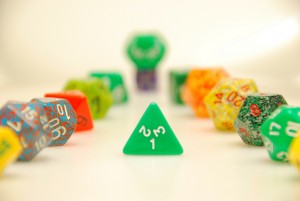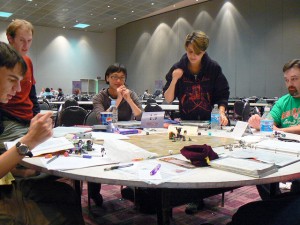A common theme of many RPGs is what could be summed up to chance: the reliance on tables and die rolls to demonstrate success or failure in a particular life task. The common belief is that by opening all actions to the will of the die roll, a fairer interpretation of what could happen in a given scenario is based on the successes or failure of the supposed skills of the character, and not the actual skills of the player.1 How would it change Dungeons & Dragons, for example, if every person playing a bard had to break out in song or strum an instrument, with the Dungeon Master (DM) as the final arbiter of accomplishment? The benefit of the die system is the core ability to be abstract; to allow numbers on a page to represent skills, abilities, and attributes of a character that either completely differ from the player or represent systems (e.g. magic) that do not exist in the postmodern world. Schallegger writes:
“With a few exceptions, randomizers such as dice or cards simulate the effects of chance and, dependent on the traits of the characters played, determine the probability of success. The published pre-texts, the written information selected and adapted from them, and the effect of the randomizers all serve as the basis for the verbal improvisation that creates an ad hoc and ephemeral verbal narrative that leaves some written remains.”2
These probabilistic elements structure Dungeons & Dragons’ core algorithmic system.

As you progress in Dungeons & Dragons, monitoring, updating, and adjusting ability and skill modifiers can become both unwieldy and pointless–you are playing the role of a computer while simultaneously playing your character. The 5th edition of Dungeons & Dragons does a great deal to take away some of this over reliance on tables and concepts.3 With computerized support systems such as D&D Beyond, a number of the complicated or tedious algorithms are removed, so one can get to the basic idea of “playing the game.”4 As McElroy explains, “the new edition’s rules are built around broad mechanics, which can be used to interpret creative ideas — without worrying about whether a character has the right predetermined powers to accomplish those feats, or how that information will be reflected on a game board.”5 The new iteration of the game, with less direct focus on die rolls and tables and more concentration on the “fun of the game,” allowed for a balance that paid homage to the tables and metrics that had become synonymous with the game since its early days with TSR and a player-centric system that optimized the enjoyment of players at all levels. I propose this model of thinking, a player-centric game working heavily on imagination and creativity, shifts the capital of Dungeons & Dragons as a role playing game away from focus and manipulation of tables.
GNS Theory, Gamists as Enterprising Power Gamers
While there have been many theories on various “types” of gamers, particularly with regard to role playing gamers, none has received more citation or critique than the GNS system developed by Ron Edwards.6 This model boils down all players into “gamists,” “narrativists,” and “simulationists” that are drawn in and motivated by various aspects of the game. The concept was developed so that game designers, specifically, could understand how to tailor their game to a particular type of player (if that was their desire), or construct elements in an analog game that could spark the imagination and interest of all “types” of gamers. In my theoretical premise, Dungeons & Dragons represents a rather open-ended system that could, in theory, provide enjoyment and opportunities for any type of gamer. A fair and dedicated Dungeon Master could construct a game with elements to excite the gamist, the narrativist, and the simulationist. Further, with the latter two categories, the act of fulfillment is very much a circumstance of mutualism between Dungeon Master and player; stories and systems require some measure of social agreement.7 An active narrativist or simulationist, in conjunction with an engaged Dungeon Master, could synergize a game that is mutually satisfying, regardless of the components of the module or adventure.
My argument is that the ever-present tables, infinite modifiers and “rule holes” created a circumstance where gamists, known in some circles as “min-maxxers” and “power gamers,” could effectively rule.8 Canny interpretation and analysis of rules led to, in particularly the 3rd and 3.5 editions of Dungeons & Dragons, an explosion of character “builds” that allowed for the maximization of skills, abilities, feats, and powers, all to make an effective killing machine that dominates any battle. While these circumstances excited gamists, they had the simultaneous effect of confounding simulationists and narrativists; an over-emphasis on the character abilities led to, in the position of some, powerhouses which were little more than collection of numbers. More and more characters flourished with ability scores and skill ranks at what would have been considered godlike if one referenced older edition texts like Deities and Demigods.9

Nicholas Mizer10 characterized the replicative nature of the algorithms, which would serve to benefit gamists, as McD&D, borrowing language from sociologist George Ritzer’s McDonalization of Society.11 The evolving system of Dungeons & Dragons through the years from its first iteration to new additions, Mizer argues, create a game that allows for elements of efficiency, calculability, predictability, and control. While Dungeons & Dragons can then shift between the “original,” Advanced Dungeons & Dragons, and stretching all the way to the newest 5th edition, a thread of consistency allows for easy reproduction of the game. The streamlining of Dungeons & Dragons, through dice systems, tables, and modifiers serves to replicate an experience across both the real and gaming worlds, allowing for players to go from game to game without much difficulty. Going along with Mizer’s ideas, it is this predictability and calculability that allows for gamists’ ability to impact the overall system.
The problem for those who objected, whether they were simulationists or narratives who were flummoxed by the concept of “winning” or Dungeon Masters who saw their carefully created encounters shattered with one roll of a die, was that the gamist/min-maxxer position was perfectly legal and within the bounds of the rules. The demand of the market for more expansion to the game cosmology led to the creation of newer, fresher character abilities. Each new ability, loosely based on canon, created new loopholes. The potentiality of new classes, prestige classes and builds that were limitless in their potential led to the creation of a new term “broken.” The concept became a discursive rebuke to gamists to imply that their characters were not illegal, but were inherently exploitative, and taking away from the enjoyment of all other players. Furthermore, Dungeon Masters had a bind: creating foes that were more than a match for these legal-but-overpowered classes would put other players, presumably most narrativists and simulationists, at a disadvantage in any battle which might lead to their untimely deaths. If the Dungeon Master chose to disallow builds and characters deemed broken, then they would be invoking favoritism: privileging narrativists and simulationists over gamists.
Bourdieu as DM – Capital and Habitus in Dungeons & Dragons
In previous writings, I have theorized that there are types of capital at the gaming table, specifically symbolic and linguistic capital surrounding archetypes in players, such as the rules lawyer.12 I posit that gamists, by introducing their powerful characters, are displaying another type of cultural capital associated with mastery of the algorithms. Being able to create, discover, or manipulate tables and character builds represents a form of “hacking the system” as it were. One of the limiting factors for Dungeon Masters who might wish to discourage gamists/min-maxxers is clear evidence that they have put in a great deal of time in the design of their characters.13 14 Whether the result of research, collaboration, or trial and error, the “broken” character is indeed a testament to the vast knowledge of the gamist. Further, to use more concepts from practice theory, creation of these characters represent a game habitus, a “feel of the game” that works within the constraints of the game algorithms.15 The “hacks” are not breaking the rules as much as they are bending them. The style of gaming is not without consequence, as the gamist character has the distinct possibility of “vastly overshadowing their peers in their area of expertise, being poorly suited to roleplaying, and disrupting the game’s balance. On the other hand, to players who primarily see and enjoy games as creative optimization problems, min-maxing is the only fun way to play games.”16

There is a fair point to say that the reboot of Dungeons & Dragons 5th edition does much to limit gamists. First, it introduces new algorithms and systems that are clearly based on the historical mechanisms, but in their own way new. Modification of this manner means the potentiality of bringing in builds, classes, or systems from prior games, otherwise known as grandfathering, would be discouraged if not wholly disallowed. An example would be the power set of psionics, which has been historically critiqued for being “broken” and overpowered. The fifth edition does not, at present, have a mechanism for allowing psionic powers. Second, the system puts clear limits on roll modifications that prevent significant disparity between characters, or imbalanced characters. For example, the stat of Armor Class is low limited where 20 is considered an exceptional score; not only do other sources provide you only minor modifications, but there is a further limitation in the potential number of modifications one can have. The new Player rules indicate that “Some spells and class features give you a different way to calculate your AC. If you have multiple features that give you different ways to calculate your AC, you choose which one to use.”17 In other words, rather than using an ad hoc systems where multiple benefits might create ridiculously high armor classes, a player chooses one system, which will give a competitive armor class, but not imbalance the game.18 This system, additionally, gives more credence and effectiveness to the idea of cover, providing an advantage to the thinking player regardless of statistics. A player who can identify cover (and inquire more about the environment) has the opportunity to use the environment; they are not as dependent on how high their armor class is or the enhancements of their weapon. In the real world, a working knowledge of one’s environment and the use of said environment, battlespace awareness, is a vital tactical skill.19 Lastly, the new edition has less reliance on mechanics managed by tables, meaning systems that were decided by numbers and rolls are now under the province of role playing.20 McElroy proclaims that the creation of systems of advantages and disadvantages “have compressed an enormous amount of the 4th Edition’s library of mechanics into two easy-to-understand (and easy-to-utilize) ideas.”21
Random chance can be a system seeming impossible in attempts to replicate, and various other researchers have noted the ineffectiveness of the die roll to fully represent the complexity of a circumstance.22 Further, role playing is in itself limited; while the magic circle is a much-embraced concept, it is not without its flaws.23 The challenge for any analog game is to try to mesh the best elements of the die roll with that of game immersion – a role playing algorithm. There is a responsibility of negotiation of balance that stretches to Dungeon Master and the player to work to maintain.24 Over emphasis on either element can lead to an experience of discomfort.
Conclusion – Slave to the Algorithm
There is cultural capital at the gaming table, much of which is valued differently in the various personalities and categorizations that are encountered. In order to function effectively in the gaming space, a player must “acquire social capital specific to the subculture, the ‘social norms and skills, social networks, gaming lore and knowledge’ (Mello, 2006, p. 178) necessary to function with others in the game’s imaginative space.”25 The problem is the capital of gamists, and their resulting use of game habitus to “hack” the system, directly impacts the fun of all other types of gamers and the Dungeon Master. There may be a detrimental social effect, as min-maxxers dominate the table, and behaviors expressed by these gamists highlight many negative stereotypes of role players in general. However, we must be knowledgeable of realities in terms of power gamers. As Taylor (2009) reminds us, “power gamers play in ways we do not typically associate with notions of fun and leisure. They, therefore, tell us something about the ways we construct those categories.”26

The fresh start of Dungeons & Dragons 5th edition allows Wizards of the Coast to honor its past while moving toward the future in a system that relies less on die rolls and more on roles. Whether this modification is due to an undeniable move toward the cyber realm (as evidenced by software such as D&D Beyond) or in response to complaints by narrativists and simulationists is irrelevant, as the end result limits the (historical) cultural capital of gamists. However, if movement away from dice and tables further pushes Dungeons & Dragons into the cyber realm, the shift could present its own issues for narrativists and simulationists. As Nick Vossen points out, online systems like D&D Beyond “may allow communication to take place on any level like in an offline game, but [are] heavily mediated by the computer, the platform and the use of mediated communication tools.”27 Eventually, as gamists are focused on winning, there will be renewed efforts in means to “hack” the system and find means to facilitate mechanisms replicating what we saw in 3rd edition and 3.5; how Wizards of the Coast moves to hinder, or embolden, these efforts will highlight whether new gamist-centric algorithms will reappear.
–
Featured image “Five to One, Baby” by Lore Sjoberg @Flickr CC-BY 2.0
–
Steven Dashiell is a PhD candidate/ABD at the University of Maryland Baltimore County (UMBC) in the Language, Literacy, and Culture department. His dissertation research investigates discursive constructs and cultural identity of male college students who were in the military. His research interests involve the sociology of masculinity, popular culture, narrative analysis, and linguistic anthropology. He has presented his work at several conferences, including the Popular Culture Association, the American Men’s Studies Association conference, Eastern Sociological Society meeting, and the American Sociological Association. Beyond the military, Steven actively researches male-dominated subcultures. He can be reached at steven.dashiell@umbc.edu.

